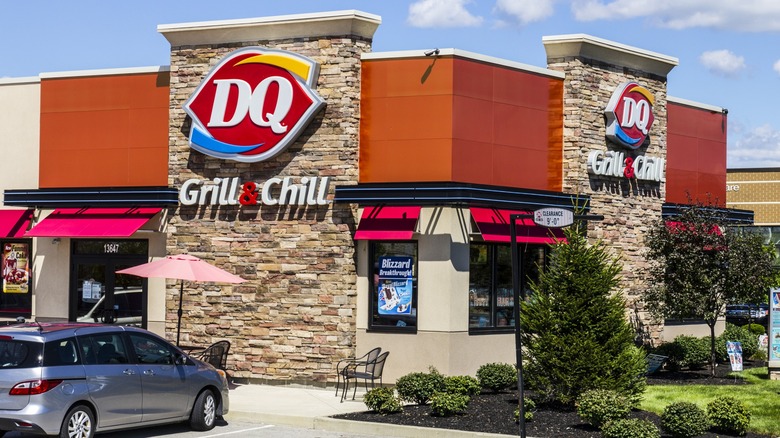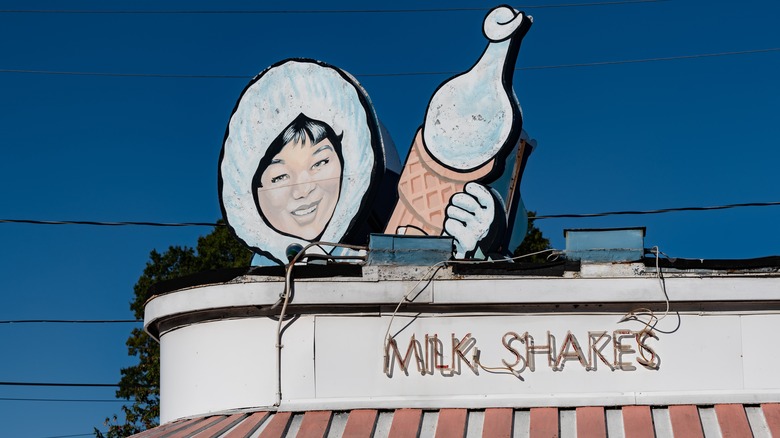The Cursed Dairy Queen Mascot We're Glad Is Gone
Fast-food mascots are a diverse bunch that have included Chihuahuas (Taco Bell), anthropomorphic purple taste buds (McDonald's), singing rats (Chuck E. Cheese), and diminutive versions of Roman figures (Little Caesars). The pantheon of mascots also included quite a few clowns, most notably Ronald McDonald (and here's what happened to McDonald's clownish mascot, in case you were curious). Like McDonald's, Dairy Queen also used a clown to advertise its cold treats, although it doesn't appear that the chain's Curly the Clown had as much staying power as Ronald (though Curly came first).
Not much is known about this mysterious, slightly off-putting clown, other than the fact that a small number of Curly signs were installed in front of select Dairy Queens at some point during the mid-20th century. One of these relics persisted until recently, when Dairy Queen corporate requested that a Shelbyville, Indiana, location remove its Curly the Clown signage from the premises. The sign had been standing tall for over six decades, and featured Curly in all his green-haired glory. It's also claimed that this signage is the last remaining depiction of Curly at Dairy Queen locations, which are now mostly identified by signs featuring the letters DQ in white over a red background and accented by orange and blue swooshes.
From cursed clown to problematic stereotype
While not everyone's cup of tea, clowns are relatively harmless (unless you're one of the few people who suffer from coulrophobia, aka a fear of clowns). However, Dairy Queen's next mascot did not present the wholesome image the chain was hoping for. Dubbed "the Eskimo girl" or "the Eskimo baby" by many customers, this signage featured a smiling girl or baby in a parka enjoying a sweet treat. Unfortunately, it also presented an offensive stereotype of an Indigenous person, complete with the use of a problematic term that many find harmful.
As reported by NPR, "Eskimo" is derived from the Ojibwe language, but its associations with stereotypical and racist views of Indigenous people have caused the word to fall out of favor. To avoid offense, many companies that had previously used the term for marketing purposes have ceased doing so (such as Edy's Pie, which is one of many food brands that changed their names). Despite these issues, some Dairy Queen locations, including one in West Virginia, continued to use the signage. Perhaps in an effort to avoid making people uncomfortable and potentially causing offense, Dairy Queen branding has steered away from off-putting clowns and stereotypes in recent years.
There's more than meets the eye in the modern Dairy Queen logo
These days, Dairy Queen relies on relatively simple signage, as compared to its previous experiments with mascots. However, the colors present in the logo actually communicate some interesting bits of information about the chain. The red background is said to replicate lips, which is exemplified by its decidedly lip-like shape. As for the colorful swooshes on the top and bottom of the signage, the orange coloring is an homage to the chain's hot menu items, while the blue swoosh pays tribute to its cool desserts such as frosty ice cream.
Dairy Queen is most beloved for its sweet, creamy treats (such as Blizzards, which aren't technically ice cream), but most locations also sell hot food. Although the chain first got its start in 1940, Dairy Queen didn't begin selling hot items until the 1950s. These days, most locations feature a good selection of food, including burgers, fries, and chicken fingers. It's all part of the evolution of Dairy Queen, as is the extended demise of a questionable clown named Curly.


